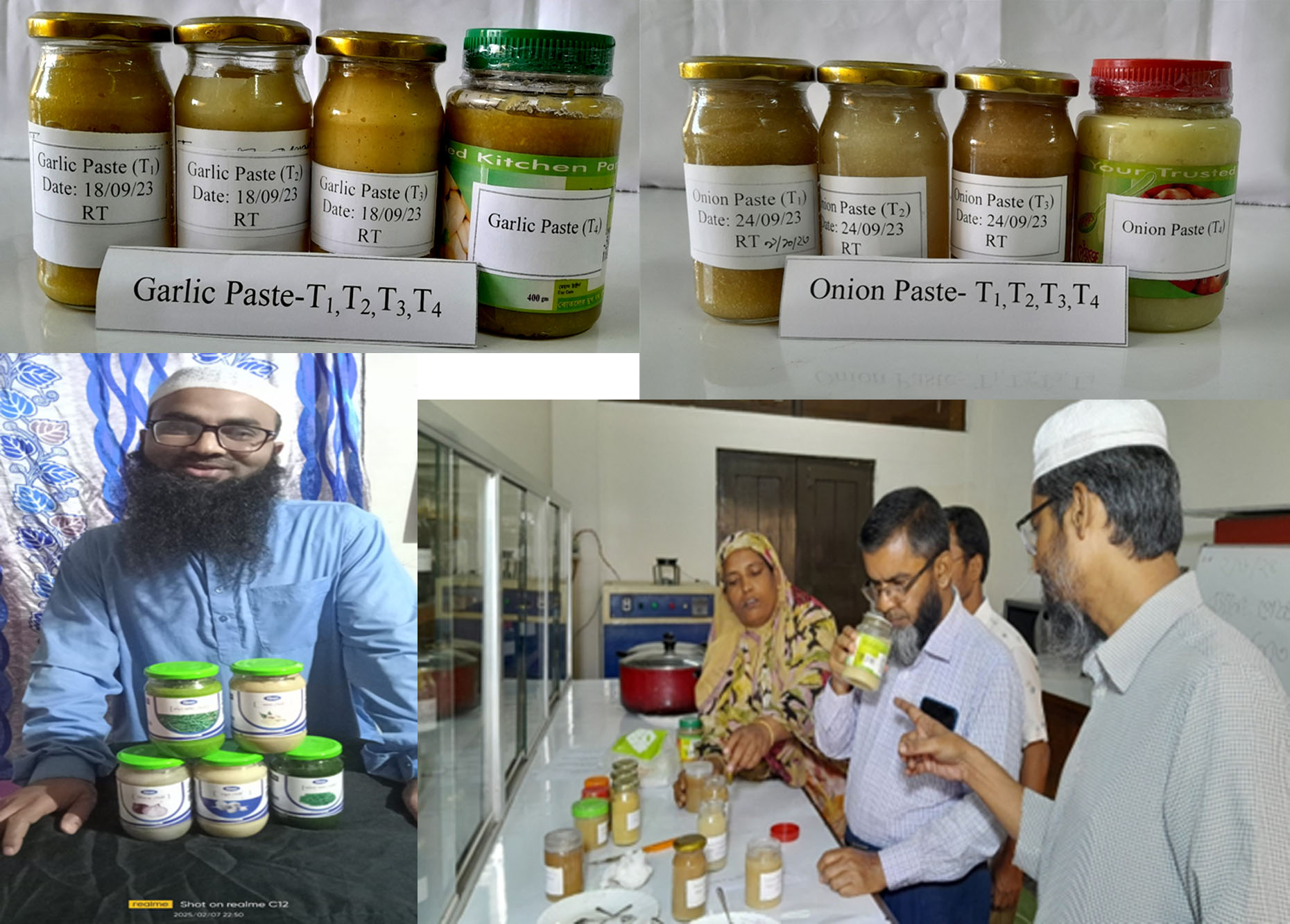Development of processing, preservation and marketing of major spices crops
Kishoreganj
Onion, garlic, ginger and chili are major spices in Bangladesh. It becomes surplus during the harvesting period which causes market price fall and make the farmer looser. Due to improper storage facilities, a big portion of post-harvest loss (20-40 %,) of these spices occur frequently (BARI Annual report, 2020) through respiration, transpiration and micro-biological activities. In some cases the loss is even more than that. BARI summer onion, ginger and green chili cannot be stored more than 15 days in ambient temperature. The imported cost of these spices were about more than thousand corer taka in each year. If the surplus produces of the selected spices crops could be conveniently and economically used for the processing of value added products by conducting research, a considerable national wastage could be reduced and farmers would get fair price of their products and thus be encouraged to increase yield and production of spices crops.
Onion, chilli, garlic and ginger processing technique will be available Different processed and semi- processed product of onion, garlic, ginger and chilli will be available Appropriate packaging materials and packaging system will be identified Storage condition of processed products will be standardized Supply chain will be identified
Postharvest losses of onion, chilli, garlic and ginger will be reduced Growers and traders will be able to sell value added product at higher prices Entrepreneurs will be developed for establishing processing industries Supply chain business model for marketing of processed spices will available
The research works were conducted at the laboratory of Spices Research Center (SRC), BARI, Shibgonj, Bogura along with institutional support and supervision. Three locations Bogura (Head quarter, Spices Research Center), Gazipur and Bandarbon districts of Bangladesh were selected for dissemination the research technology. The onion, garlic and ginger were first peel, wash with clean water and sliced. The spices paste was prepared by blending sliced onion, garlic and ginger in a blender/crusher using 100 ml water per kg of sliced spice.The spices paste were treated in three ways; T1- spice paste with 10% salt + 1% citric acid + 1000ppm sodium benzoate, T2- Spice paste with 10% salt + 1% citric acid + 1000ppm potassium metabisulphite, T3- Spice paste with 1% citric acid andT4- Spice paste was collected from local market The nutritional study, shelf life, microbiological study and sensory are going on at Spices Research Center, Bogura and Postharvest Technology Division of BARI, Gazipur and another outside recognized laboratory. Post-harvest activities, hands on training program, discussion, meeting program are going on with innovative farmers, different stakeholders and small level entrepreneurs at selected locations in presence of DAM, DAE, BFSA personnel. The generate technology will help the entrepreneur to develop value added products for marketing.
As per sensory and physiochemical study the highest shelf life 270 days was found for onion paste in glass bottle by treatment T2 (treated with NaCl + CA+ KMS) at room temperature, closely followed by T1 (treated with NaCl + CA + sodium benzoate) with 180 days shelf life and T3 (treated with CA) with 75 days shelf life for same storage condition. In case of plastic pot the shelf life of same products was significantly less: e.g. 180 days for T2 150 days for T1, and 60 days for T3 and T4 packed in plastic pot and stored in room temperature storage. It is also observed that in refrigerated storage the highest shelf life of onion paste 300 days was found in T1 and T2 for both glass bottle and plastic pot, but T3 showed 150 and 120 days shelf life when it was packed in glass bottle and plastic pot. The lowest shelf life of onion paste 90 days was found in T4, when packed in plastic pot.
The color, flavor, texture and overall acceptability of the onion, garlic and ginger-garlic mix pastes, treated with sodium chloride plus citric acid plus KMS which was stored in glass container at room and refrigerated temperature were more acceptable up to 180 and 270 days of storage compared to other treatments. It was also found that the color was more natural in refrigerated storage compared to room temperature.
Value added and ready to use processed spices may increase in project areas at the end of the project. As a result, the demand for different ready to use spice paste may increase. Interested trained entrepreneur can go for processed spice production which will minimize postharvest loss, earn money and create employment opportunities.
-
Value added products of onion and garlic paste were developed. Twenty entrepreneurs from different districts were trained on processing, preservation and marketing of spices products. The 1st year research progress is satisfactory.
(04-Feb-2025)

